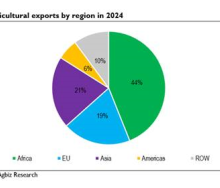Global goods trade is projected to post a 2.7% increase in 2024, up slightly from the previous estimate of 2.6%, WTO economists said in an updated forecast on October 10.
The volume of world merchandise trade is likely to increase by 3.0% in 2025; however, rising geopolitical tensions and increased economic policy uncertainty continue to pose substantial downside risks to the forecast.
Services trade, however, has a more favourable outlook compared to goods according to leading indicators.
In the October 2024 update of “Global Trade Outlook and Statistics,” WTO economists note that global merchandise trade turned upwards in the first half of 2024 with a 2.3% year-on-year increase, which should be followed by further moderate expansion in the rest of the year and in 2025. The rebound comes on the heels of a -1.1% slump in 2023 driven by high inflation and rising interest rates. World real GDP growth at market exchange rates is expected to remain steady at 2.7% in 2024 and 2025.
Inflation by the middle of 2024 had fallen sufficiently to allow central banks to cut interest rates, says the report, which suggests that lower inflation should raise real household incomes and boost consumer spending, while lower interest rates should raise investment spending by firms.
Director-General Ngozi Okonjo-Iweala said: “We are expecting a gradual recovery in global trade in 2024, but we remain vigilant of potential setbacks, particularly the potential escalation of regional conflicts like those in the Middle East. The impact could be most severe for the countries directly involved, but they may also indirectly affect global energy costs and shipping routes. Beyond the economic implications, we are deeply concerned about the humanitarian consequences for those affected by these conflicts.
“It is imperative that we continue to work collectively to ensure global economic stability and sustained growth, as these are fundamental to enhancing the welfare of people worldwide. In the past three decades since the WTO was established, per capita incomes in low- and middle-income economies have nearly tripled. We must continue our efforts to foster inclusive global trade,” DG Okonjo-Iweala said.
From a regional point of view, there have been notable changes in GDP forecasts, including a 0.4 percentage point upgrade to North America's growth, which could influence trade flows in other regions as well, says WTO chief economist Ralph Ossa.
Asia's export volumes will grow faster than those of any other region this year, rising by as much as 7.4% in 2024.
The region saw a strong export rebound in the first half of the year, driven by key manufacturing economies such as China, Singapore and the Republic of Korea. Asian imports show divergent trends: while China's growth remains modest, other economies such as Singapore, Malaysia, India and Viet Nam are surging.
Africa's export growth has been revised downward from the April forecast, driven by an overall revision of Africa's trade statistics, and a greater-than-expected weakening in Europe's imports, Africa's main trade partner.













